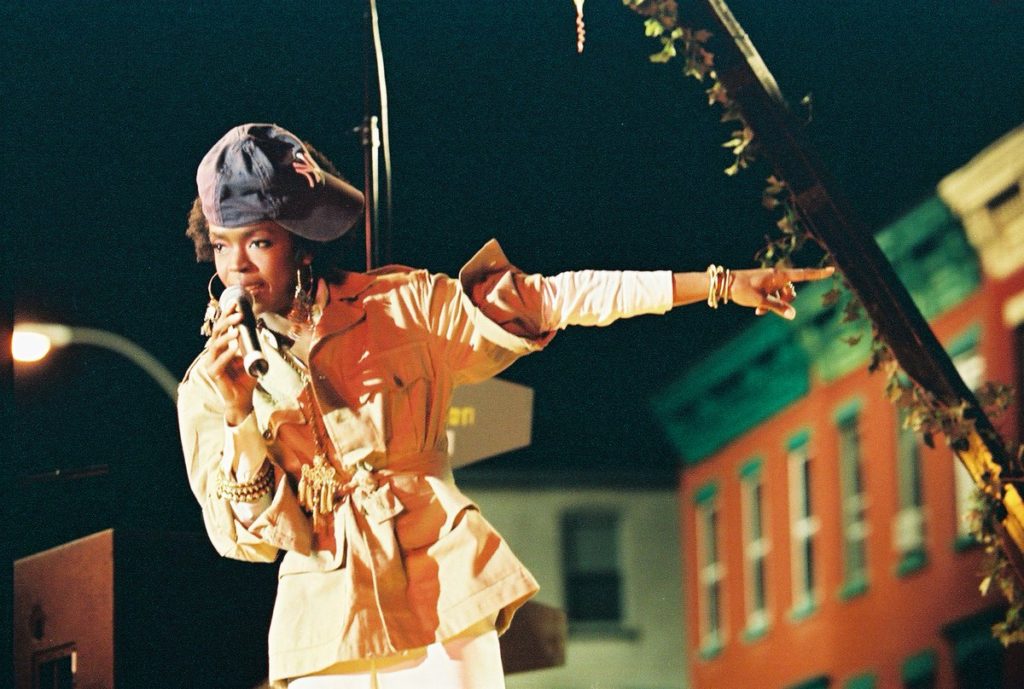
The companion album to 2005’s Dave Chappelle’s Block Party begins with the beep of a telephone. A conference call ensues between the titular comedian and the musical lineup. Long-awaited hellos emerge from the static-filled communications, mirroring the warm and familiar tone of the film they contribute to — which opens on Chappelle approaching a sputtering, broken-down car two neighborhood men are pouring their elbow grease over. The title Block Party reminds us that this is not a concert, and candid moments such as these serve to refocus the audience in terms of the film’s purpose. The community attending, and the genuine behind-the-scenes assembly intercut throughout, soak up a spotlight typically reserved for performances in the concert film genre. Entire songs are abruptly cut or interrupted by backstage rehearsals, location scouting, and Chappelle on the street spreading the good news. Yet, aside from the smooth raps that glide your head like a knife through butter and the authenticity of the events captured, perhaps the film’s most overlooked component is that its Black performances double as acts of liberation.

Back to the car. The engine sputters again, and the spray of WD-40 is interrupted by the crescendo of a marching band’s practice. Chappelle announces the lineup as if he were a community track and field supervisor, promoting the musical guests via megaphone while dancing to the Brooklyn Steppers’ pronounced horns against the backdrop of prismed projects. “This is the concert I’ve always wanted to see,” he states.
If this were a spelling bee, the artists competing would face disqualification after substituting the ‘c’ in “America” with a ‘k.’ Thankfully, they speak to truth that runs deeper than proper spelling. Said lineup is astounding, featuring everyone who’s anyone, including Kanye West in his breakout year, the radical Dead Prez and Black Star, and the Fugees—after a nearly decade-long hiatus apart — not to mention the incomparable Erykah Badu and Jill Scott, whose soulful cadence echoes the reggae strain of the deepest Marley cuts. “I think we all have an important message we try to get across, and it’s about more than just making money,” Chappelle says of his fellow performers, failing to mention that he funded the event entirely from his own pockets.
Produced only months before he walked away from 50 million dollars and his hit Comedy Central series, Block Party provides a raw 16mm portrait of the artist Dave Chappelle and the community he feels he’s failed. (“I was doing sketches that were funny, but socially irresponsible,” he laments in his 2006 Oprah interview.) The film is a size too big to fit such a description, standing the test of time and Chappelle’s assumptions of his work by providing a Wattstax for a generation who considered him their Pryor. Chappelle administers a healthy dose of levity, much like Pryor, who jokes between performances that pay tribute to the Watts riots which occurred seven years earlier. Block Party ferociously channels the 1973 film’s political scope, in the same vein of Chappelle’s own Black Bush and Tony Blair skits. “Canada? What, you trying to dodge the war?” he retorts after hearing a woman from his town in southwest Ohio turn down the invitation.
“And I just wanted people from around the area that I live in that might not normally go to something like this… to get a chance to experience something like this,” Chappelle explains to his majority-white townsfolk in Ohio upon inviting them. A champion against the notion of the single-story narrative, the block party is for everyone — including parole officers, elderly white women, and Black teens invited and bussed by Chappelle from Ohio to New York. Ultimately, they all play roles as the supporting cast; recurring appearances highlight their gleeful reactions between musical performances. Some even have stars of fame imprinted on the theatrical poster. Most endearing of all is Chappelle’s invitation to Central State University’s marching band, whose instrumental backing on Kanye’s “Jesus Walks” performance outshines the artist. The stochastic editing is adamant about interrupting his stage swagger with the marchers’ routine, even while a young John Legend backs on vocals. “Seeing all these people out here with locks, it’s comfortable,” a band member tells the camera after their performance, later stating, “…celebrities, they just like me. They were happy to see me doing my work like I’m happy to see them doing theirs.” The representation on screen is inspiring, and any detractors who claim otherwise should note a young J. Cole in the crowd.
Block Party never gets caught up in the featured artists’ larger-than-life images, focusing instead on brush, canvas, and the community they seek to represent through their work. And that community is Black. Much like Wattstax — no doubt an inspiration for Chappelle and his team — the film is by Black artists for the Black community. Block Party serves as a relief for the diaspora living in Bush’s America. Only a year later, Kanye would infamously criticize the administration’s response to Katrina on live television. “There’s a lot of talk going around about terrorism,” Fred Hampton Jr., the son of Black Panther leader Fred Hampton — who was assassinated in his home by police — says alongside Black Star onstage. “We say Black people are the O.V.’S, the original victims of terrorism,” he continues, championing the power fist, which everyone unanimously sends up, the camera panning to white band players doing the same.
Chappelle’s production company logo features the color scheme of the Pan-African flag; however, many fail to notice the theme of Black liberation woven throughout the film. To the artists and community presented, this is clear. Fred Hampton Jr.’s brief appearance is hand-wringing enough to warrant the discussion, yet it seems lost on most critics and audience members of the time. The film explores the idea of art as the liberating force, and no performers (except for Dead Prez) elucidate this notion better. Chappelle recites their lyrics on a rooftop: “The white house is the rock house! Uncle Sam is the Pusher Man! Who shot Biggie Smalls? If we don’t get them, they gon’ get us all.” He explains: “People stopped asking who shot Biggie Smalls, but if you in show business and Black, you wonder about that every day. ‘Cause they might get you too.” Here, he further connects the notion of Black liberation with the precarious business of being a Black performer.
Aside from Chappelle’s scalper-like word of mouth on the street, another of the film’s many bargains is its emphasis on digitization, which illuminates the beginning of a digital millennium. The occasional shot from the crowd tends to hyper fixate on whatever then cutting-edge camera device an audience member may be holding. Busloads of attendees boast to the crew “1iota.com” when questioned on how they located the party’s site. It vaguely suggests, although naively, a collective beauty in the Internet age, posing it as a model of organization for show and celebration. A time that made so many grow old so young to the horrors faced by the community represented on-screen through screens of our own. “I know I shouldn’t be swearing to you kids, but this shit is all online anyway,” Wyclef Jean states in front of the marching band. Even then, there was a foreboding sense this community knew there was much worse soon to be seen there as well. It’s a far cry from the reasons we network gatherings today, reminding us of a time they were orchestrated online to provide music to our ears first, rather than to combat the white political noise disrupting it.
Such noise has always been on these artists’ minds. One which is only drowned out by their sea of creativity. An outlet of liberating vigor that sparked their respective genres, which charge a dehumanized community with power. The performances do just that, with the majority of the music arranged and directed by Questlove. The Roots frontman looks otherworldly on backing drums with other members of the collective in close orbit. Hip-Hop dominates the sound on stage as a still nascent genre whose pioneers litter their flow with trash talk and recycled messages of freedom. Mos Def’s eclectic flow adds flavor to the pot, which boils in Dead Prez’s intensity and steams in the aftermath of Badu’s neo-soul. The aching performance of “Killing Me Softly” reminds us why we mend ourselves with Lauryn Hill’s motherly lullabies, closing the concert out on a warm and graceful note. These acts revel in the setting, which doubles as the birthplace of many of the artists present.
“This is New York when you’re on the rooftop. Every time you show a movie, it always show somebody on the rooftop,” a man says halfway through the film. The corner of Downing and Quincy in Bed-Stuy, Brooklyn, serves as the ideal get-down location, surrounded by buildings symbolic of the music featured. Chappelle visits the thrift store, explaining the relationship between comedians and musicians while playing Thelonius Monk’s “Round About Midnight” on an out-of-order piano, a man whose unique musical timing shares the same beats as the editing of the film. The cuts traverse layers of time and space, only unveiling the rooftop Chappelle and his crew will be filming on as that of Biggie Smalls’ childhood daycare long after we set foot on it. The other location, rearing the stage, is aptly named the “broken angel house.”

At its core, Dave Chappelle’s Block Party is a concert film with no interest in being a concert film. The performing artists are not the only subjects of the film, with audience members and community receiving the limelight, too. The levity implemented by Chappelle balances the serious tones laced through the lyrics and activism presented. This enjoyment is experienced by home viewers years later due to its blissful nature. Even if Chappelle’s comedy doesn’t do it for you, there’s no doubt this is the feature we need right now. It’s both radical and feel-good, featuring a community and their call for freedom that has yet to be answered.